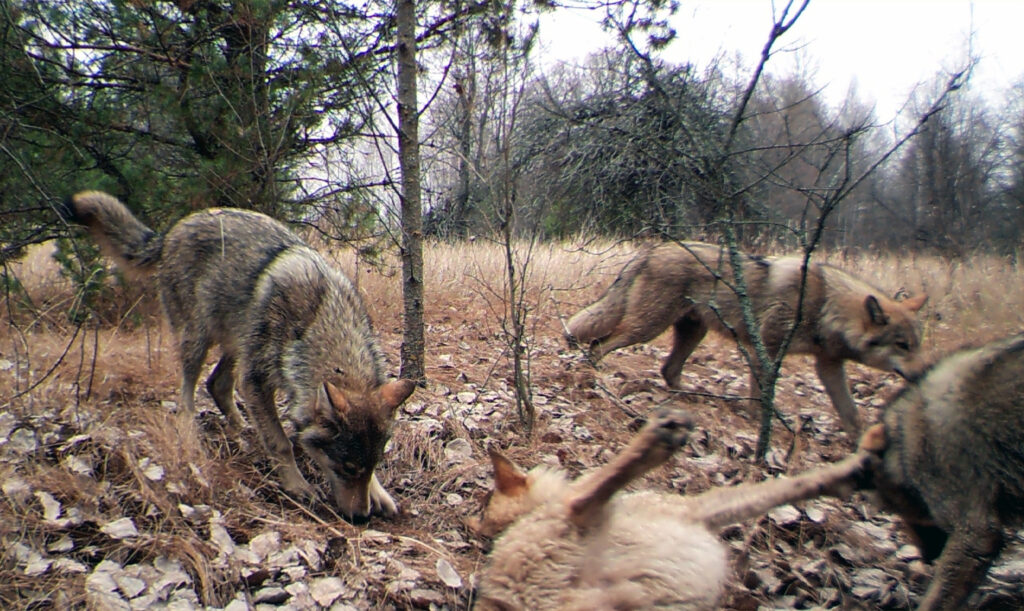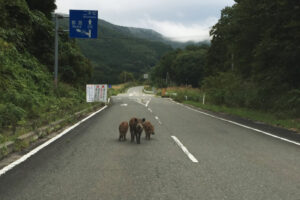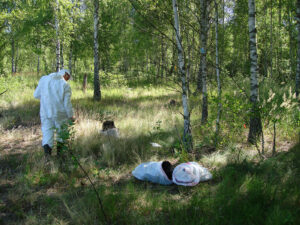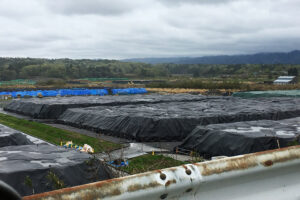Wildlife Impacts At Chornobyl, Fukushima May Yield ‘A New Ecology’
Dec 27, 2023 | Pratirodh Bureau
Wolves in Chornobyl seen via a camera trap. Scientists have not found Chornobyl wolves’ abundance to be impacted by radiation, perhaps due to their extensive ranges and reduced human pressure (Image courtesy of James Beasley)
- The world’s worst nuclear power plant accidents to date, at Chornobyl, Ukraine, in 1986, and Fukushima, Japan in 2011, and the human exclusion zones created around them have given scientists a unique opportunity to study the effects on wildlife of radiation and of reduced pressure from people.
- Chornobyl disaster findings regarding the impacts on exclusion zone organisms vary: Some point to a resurgence of the studied wildlife in the absence of humans, while others indicate radiation negatively impacting certain animal populations.
- Fukushima radiation impacts are statistically harder to detect. But scientists have made similar observation to Chornobyl: Some, but not all, species appear to thrive from reduced human pressure.
- Radioactive contamination moves in ecosystem-specific ways, depending on factors such as water flow. A combination of radioactive contamination and reduced human activity in nuclear exclusion zones may be giving rise to “a new ecology,” with nature overall neither suffering nor thriving, simply different in the impacted areas.
Note to readers: “Chornobyl” is the Ukrainian spelling of “Chernobyl,” which is the Russian version, a spelling change requested by the Ukrainian government following its independence from the USSR. Mongabay has chosen to use the Ukrainian spelling throughout this story.
Wolves lope through the Chornobyl nuclear power plant exclusion zone in the 2019 documentary Our Planet, as naturalist and TV presenter David Attenborough reminds viewers: “Hunters like these would only return if their prey and the surrounding forest is also thriving.
“No unprotected human being can stay here for long without lethal risk,” he then explained, “But in driving us out, the radiation has created space for wildlife to return.”
Attenborough is not the first to claim that nature can thrive in nuclear exclusion zones; indeed, the Our Planet script drew from scientific literature. However, there’s no consensus among the scientific community on this question, with researchers continuing to investigate and debate the ongoing effects of radioactive contamination on the environment in Chornobyl, Ukraine, and in Fukushima, Japan — the sites of the world’s two worst nuclear power plant accidents to date.
Although individual-level radiation impacts on numerous animal and plant species have been widely observed and acknowledged, some researchers have found evidence of population-level, or even ecosystem-level impacts, while others haven’t. Study design, including target species, sample size, and method of estimating radiation dose, potentially colors these findings.
Others argue that the body of research on nuclear exclusion zone organisms and ecosystems point in sum to neither a restoration, nor to a diminishing of the wild — but to “a new ecology.”
What is clear is that in a world where more than 400 nuclear plants are currently in operation — with more than 100 such facilities over 40 years old; and with many new, though smaller nuclear plants in the works — it’s important to recognize and analyze impacts on wildlife and habitat if we’re to be prepared for future mishaps.
On a far bigger scale, humanity’s release of significant amounts of radiation globally is included within the novel entities planetary boundary, which incorporates a vast number of other harmful synthetic pollutants ranging from plastics to pesticides. The “safe operating space” threshold for the novel entities boundary was declared transgressed in 2022 by scientists. Six planetary boundaries, including climate change and biosphere integrity, have already been crossed, placing life on Earth as we know it at risk.
The Radioactive Mosaics Of Chornobyl And Fukushima
The 1986 Chornobyl nuclear power plant accident, the largest in history, forced the evacuation of roughly 116,000 people in Ukraine and Belarus from a 4,200-square-kilometer (1,600-square-mile) zone surrounding the plant, which occupies a flat marshland ecosystem partially drained by human engineering. Today, the zone covers 2,800 km2 (1,100 mi2) in Ukraine, as well as the 2,162-km2 (835-mi2) Polesie State Radioecological Reserve in Belarus.

The 2011 Fukushima Daiichi nuclear accident, the world’s second-largest, released roughly one-tenth as much radioactive material as Chornobyl. As the disaster unfolded, roughly 160,000 people were evacuated from a 1,150-km2 (444-mi2) area around the plant. Although part of the original exclusion zone has been reopened, 337 km2 (130 mi2) stretching northwest from Fukushima Daiichi remain closed; the area covers both coastal lowlands and mountains.
Neither exclusion zone is untouched by people, with power plant and cleanup workers, guards, tourists (replaced by soldiers in Chornobyl following Russia’s invasion of Ukraine), trespassers, loggers, and hunters and trappers active in either or both zones.
Radiation levels within the zones are mosaic-like and heterogenous, with both highly radioactive and relatively “clean” patches created by fallout patterns and subsequent redistribution of radionuclides by humans and nature. At Chornobyl, for example, radiation levels in the zone can jump between four orders of magnitude depending on where you measure.
Individual organism exposure to radiation is similarly complex and varied. Exposure can be external (caused by being in proximity to radioactive materials in the environment), or internal (due to ingesting radioactive materials). Although not all types of radioactive material present a danger through external exposure, all are potentially hazardous if ingested. Many radionuclides — including iodine-131, cesium-137, strontium-90, and plutonium-239 — are known to remain in bodies and bioaccumulate. An individual organism’s total dose, therefore, depends on multiple factors such as diet and range.
Wildlife impacts: Radiation vs. reduced human pressure
One area of scientific inquiry conducted at both sites has looked at whether radiation affects medium and large mammal populations.
A 2015 census of large mammals at Chornobyl, using data from winter track surveys published by the Belarusian government along with helicopter surveys, found “no evidence of a negative influence of radiation on mammal abundance” compared with other wildlife preserves in Belarus. A 2016 Chornobyl camera trap study also found that, based on animal detections at 94 scent stations over a five-week period, the exclusion zone’s varying radiation levels had “no discernible impact on the current distribution of selected mid- to large-sized carnivores, or of Eurasian boars” within the zone.
A 2020 camera trap study comparing mammal populations inside and outside the Fukushima exclusion zone found “many mid- to large-sized mammals have responded favorably to the removal of humans,” despite the area’s radiological contamination.
In Fukushima, “a lot of the species that are most in conflict with people, boar and macaques and [other animals], were most abundant in the exclusion zone,” James Beasley, a professor at the University of Georgia in the U.S. who contributed to all the above studies, told Mongabay. In Chornobyl, animals that have traditionally faced persecution, like wolves and game animals, have benefited from reduced human pressures, he said.
However, the presence of large mammals in these zones doesn’t mean that radiation isn’t harmful, Beasley cautioned.
Camera traps and tracks in snow, while useful for determining population increases or decreases, can’t provide data on individual animal health. Part of Beasley’s current research focuses on molecular-level radiation effects, as well as accurately estimating individual animals’ exposure, including through the use of dosimeter-GPS collars.
Detecting Radiation Damage
For Timothy Mousseau and Anders Møller, scientists who have been studying exclusion zone organisms for two decades, there is “no evidence of any threshold below which [radiation] effects are not potentially observable given sufficient statistical power.”
“It’s relatively easy to investigate individual-level effects,” Mousseau, a professor at the University of South Carolina, U.S., told Mongabay. Through their fieldwork, particularly in Chornobyl, he and Møller have recorded increased mutation rates, immunological changes, physical body changes, and increased tumor rates in wildlife due to radiation, among other findings.
Population-wide analysis, however, is trickier: It requires high levels of scientific rigor and statistical power. To gather such data, Mousseau and Møller took “massively replicated biotic inventories” in the field, counting individuals and species across hundreds of locations over several years, while also noting environmental factors including, of course, radiation levels.
Fukushima data is “less rigorous” compared with Chornobyl because less radiation was emitted in the Japanese accident, making radiation effects statistically much harder to detect, said Mousseau. “The lower the range, the larger the sampling design you need to detect the effect,” he added. “It doesn’t mean it’s not there. It just means that it’s below your detection ability in many cases.”
The two scientists’ most thorough studies were of birds and bugs. A 2022 review by Mousseau, Møller and other researchers of numerous studies (including their own) found that, while bird species were not all equally affected by radiation exposure, on average birds’ populations in both Chornobyl and Fukushima decreased with increasing levels of background radiation. In field surveys of bumble bees, butterflies, grasshoppers, dragonflies and spiderwebs conducted in Chornobyl between 2006 and 2008, Mousseau and Møller observed abundance decreasing with increasing radiation.
The pair conducted their own mammal track survey in 2009 at Chornobyl, with results published in 2013 showing “many more mammals in less contaminated areas,” despite significant differences by species. The pair collaborated with researchers from Finland’s Jyväskylä University in a 2019 study that found higher radiation levels corresponded to a decrease in abundance and breeding success in Chornobyl bank voles.
Different species have different sensitivity to radiation, explained Mousseau. He acknowledged that some species, such as wolves and some birds, do appear to respond positively to living in exclusion zones, but that’s likely thanks to reduced pressure from competitors or predators.
“Which is more important for these different species, direct human disturbance or the effects of radiation? The answer is that it depends on where you are and what kind of species you are,” Mousseau said, noting that it may be harder to detect radiation effects in species with large ranges.

Radiation may even have had ecosystem-level effects at Chornobyl. A 2014 study by Mousseau and colleagues found that radioactive contamination reduced the rate of leaf litter decomposition, which could affect plant growth conditions, an impact that, if strong enough, could reverberate through an ecosystem. They also reported in 2012 that fruit trees and bushes in highly contaminated areas produced fewer fruit, partially due to decreases in pollinating insects; fruit-eating birds were also less common in these more radiated areas.
‘A New Ecology’
While highly polarized “nature is thriving” versus “nature is suffering” narratives often dominate popular discourse about nuclear exclusion zone wildlife — especially when scientific studies are interpreted by media coverage — neither side of the discussion represents the whole truth, said University of Oxford postdoctoral researcher Jonathon Turnbull in an interview with Mongabay. Turnbull’s research has focused on unpacking these narratives.
In his view, nature as a whole isn’t “doing badly,” as different species react to radiation in different ways (radiotrophic fungi, for example, even appear to feed off it). However, Chornobyl’s nature isn’t “bouncing back to what it once was.” Instead, “There’s an emergence of a new ecology,” Turnbull said.
Mapping the ecosystem-specific movements of radiation is one key to understanding these new ecologies. The ecosystem surrounding the Chornobyl nuclear plant, the Prypiat Marshes, was particularly suited to taking up and spreading radiation, according to Massachusetts Institute of Technology professor Kate Brown, whose research on Chornobyl from Soviet archives unearthed “evidence that Chornobyl radiation caused a public health disaster in the contaminated lands.”
In her archival research, Brown found a pre-Chornobyl survey of radioactive fallout in the Prypiat Marshes from global nuclear weapons tests. That survey illustrated how the marshes’ seasonal flooding redistributed radioactive particles in a heterogenous pattern. (Starting in the 1960s, part of the Prypiat Marshes was drained to create farmland, and later to build the Chornobyl nuclear power plant. Another part of the wetland was used as a bombing range.)
The relatively low availability of minerals in marsh ecosystems means that plants and fungi more readily take up radioactive particles, which mimic such minerals. These particles then accumulate in farm animals as they graze.
“Through that process of biomagnification, radioactivity tends to move up the food chain, and the organisms at the top of the food chain are humans,” Brown told Mongabay.
Environment-specific movements of radioactive particles have been found in Fukushima as well. In 2017, the Woods Hole Oceanographic Institution in Massachusetts, U.S., reported that radioactive cesium in the ocean (80% of Fukushima fallout occurred over the ocean), accumulated in sands and groundwater beneath beaches up to 100 km (60 mi) away from the disabled nuclear power plant. Over time, the particles started flowing back into the ocean on a level comparable with releases and runoff from the power plant itself, and from rivers carrying particles to the ocean from land.

Both Brown and Turnbull emphasized the porous nature of nuclear exclusion zone borders, which are frequently crossed by humans and animals, and beyond which radioactive particles are redistributed over time by both natural processes and human activities. In Brown’s view, exclusion zones are sometimes used as “a political maneuver of the state to say, ‘We’re dealing with this [radioactivity] problem.’”
In Chornobyl, human activities such as berry picking and logging on contaminated land have redistributed radioactive materials via human supply chains. Likewise, forest fires have moved radiation from plants and soils back into the atmosphere. Since Russia’s invasion of Ukraine, military activities, too, have disrupted the exclusion zone. In Fukushima, wastewater containing radioactive materials, proclaimed safe by nuclear regulatory bodies, is being discharged into the ocean. Extreme weather, such as typhoons and heavy rains now worsened by climate change, send particles downhill and downstream.
Scientists say further research into the relationships between radiation, organisms and ecosystems — not just debates over what level of radiation is “safe” or whether an area is “clean” — is needed.
“Once we accept that we’re polluted,” Turnbull said, emphasizing radiation’s ubiquity, “maybe we can start to find new ways of living with this.”
